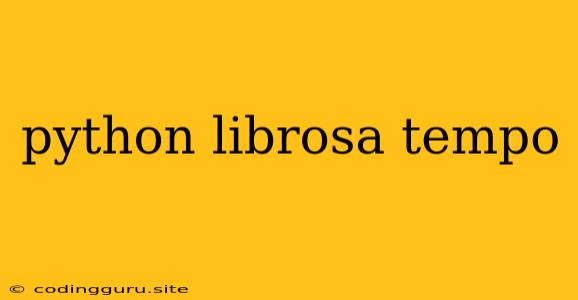Understanding Tempo with Librosa in Python
Librosa is a powerful Python library designed for audio and music analysis. It provides a comprehensive suite of tools for tasks like feature extraction, signal processing, and music information retrieval (MIR). One particularly useful feature of Librosa is its ability to analyze and estimate the tempo of an audio track.
What is Tempo?
Tempo, in musical terms, refers to the speed or pace of a piece of music. It is typically measured in beats per minute (BPM). Understanding tempo is crucial for various applications, including:
- Music analysis: Identifying the tempo of a song can help understand its genre, mood, and overall structure.
- Music editing: Tempo estimation is essential for tasks like beatmatching, loop creation, and time stretching.
- Music generation: Knowing the tempo of a piece can guide the creation of new music with a similar feel.
Librosa's Tempo Estimation
Librosa offers several methods for estimating tempo. The most common approach uses the Beat Tracking Algorithm, which aims to identify the strongest beats in a piece of music.
How does Librosa Estimate Tempo?
- Feature Extraction: The first step involves extracting relevant features from the audio signal. These features usually include the onset envelope and the spectral centroid.
- Beat Detection: The features are then used to identify potential beats in the audio signal.
- Tempo Estimation: Finally, Librosa analyzes the timing between the detected beats to estimate the tempo in BPM.
Example: Extracting Tempo from an Audio File
import librosa
import numpy as np
# Load audio file
audio_path = 'your_audio_file.mp3'
y, sr = librosa.load(audio_path)
# Estimate tempo using librosa.beat.beat_track
tempo, beat_frames = librosa.beat.beat_track(y=y, sr=sr)
print("Estimated Tempo:", tempo)
In this code snippet:
librosa.load()loads the audio file and returns the audio signal (y) and the sampling rate (sr).librosa.beat.beat_track()is used to estimate the tempo using the beat tracking algorithm.- The output
temporepresents the estimated tempo in BPM.
Tips for Accurate Tempo Estimation:
- Ensure high-quality audio: Use high-quality audio files with minimal noise for better results.
- Experiment with different algorithms: Librosa offers several tempo estimation methods. Try different approaches to find the best fit for your specific audio.
- Consider the context: The estimated tempo may not always reflect the perceived tempo, especially in complex musical pieces with multiple tempos.
Beyond Tempo Estimation: Applications of Librosa
Librosa's capabilities extend far beyond tempo estimation. It can be used for a wide range of audio analysis tasks, including:
- Pitch detection: Analyzing the pitch of a sound.
- Chroma features: Representing the musical notes in an audio signal.
- Mel-frequency cepstral coefficients (MFCCs): Extracting features for audio classification and recognition.
- Audio segmentation: Dividing an audio signal into meaningful segments.
Conclusion
Librosa is a valuable tool for anyone working with audio analysis in Python. Its powerful functions and user-friendly interface make it easy to extract meaningful information from audio signals, including the crucial metric of tempo. By understanding tempo, you can unlock a wealth of possibilities for music analysis, editing, and generation.
